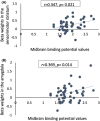A multimodal neuroimaging study of youth at risk for substance use disorders: Functional magnetic resonance imaging and [18F]fallypride positron emission tomography
- PMID: 39725679
- PMCID: PMC11828974
- DOI: 10.1111/acer.15511
A multimodal neuroimaging study of youth at risk for substance use disorders: Functional magnetic resonance imaging and [18F]fallypride positron emission tomography
Abstract
Background: Adolescent alcohol use is the norm, but only some develop a substance use disorder. The increased risk might reflect heightened mesocorticolimbic responses to reward-related cues but results published to date have been inconsistent.
Methods: Young social drinkers (age 18.5 ± 0.6 y.o.) who have been followed since birth were recruited from high- versus low-risk trajectories based on externalizing (EXT) behavioral traits. All had functional magnetic resonance imaging (fMRI) scans to measure mesocorticolimbic responses to alcohol, juice, and water cues (High EXT: 20F/10M; Low EXT: 15F/12M). Most had positron emission tomography (PET) [18F]fallypride scans to measure brain regional dopamine D2 receptor availabilities (n = 47).
Results: Compared with the low EXT group, high EXT participants reported larger subjective responses to the alcohol and juice cues (vs. water). Despite this, a main effect of group was not seen for brain activation responses to the alcohol and juice cues. Instead, low EXT participants exhibited higher mesocorticolimbic activations to alcohol than juice, whereas these activations did not differ in the high EXT group. Across all participants, alcohol (vs. water) blood oxygen level-dependent (BOLD) responses in the striatum and amygdala were associated with midbrain [18F]fallypride BPND values.
Conclusion: Young social drinkers at high versus low risk for substance use disorders did not exhibit larger mesocorticolimbic BOLD activations to alcohol-related cues and their responses poorly differentiated alcohol from juice. These observations raise the possibility that (i) diminished mesocorticolimbic BOLD differentiations between reward-related cues might be a marker of increased risk for substance use disorders, and (ii) previously reported large BOLD responses to drug-related cues in people with substance use disorders might better identify the disease than pre-existing vulnerability.
Keywords: addiction; biomarker; endophenotype; reward processing.
© 2024 The Author(s). Alcohol, Clinical and Experimental Research published by Wiley Periodicals LLC on behalf of Research Society on Alcohol.
Conflict of interest statement
The authors declare no conflicts of interest.
Figures





References
-
- Behar, L. & Stringfield, S. (1974) A behavior rating scale for the preschool child. Developmental Psychology, 10, 601–610. Available from: 10.1037/h0037058 - DOI
-
- Benjamini, Y. & Hochberg, Y. (1995) Controlling the false discovery rate: a practical and powerful approach to multiple testing. Journal of the Royal Statistical Society: Series B: Methodological, 57(1), 289–300.
-
- Bernstein, D.P. & Fink, L. (1998) Childhood trauma questionnaire: a retrospective self‐report. London: The Psychological Corporation.
Grants and funding
- MOP-133537/CAPMC/ CIHR/Canada
- MOP-44072/CAPMC/ CIHR/Canada
- MOP-97910/CAPMC/ CIHR/Canada
- 981055/Fonds de Recherche du Québec - Santé
- 35282/Fonds de Recherche du Québec - Santé
- 991027/Fonds de Recherche du Québec - Santé
- 2002-RS-79238/Fonds de Recherche du Québec-Société et Culture
- 2009-RG-124779/Fonds de Recherche du Québec-Société et Culture
- 410-99-1048/Social Sciences and Humanities Research Council of Canada
- 839-2000-1008/Social Sciences and Humanities Research Council of Canada
- MOP-133537/CAPMC/ CIHR/Canada
- MOP-44072/CAPMC/ CIHR/Canada
- MOP-97910/CAPMC/ CIHR/Canada
LinkOut - more resources
Full Text Sources

